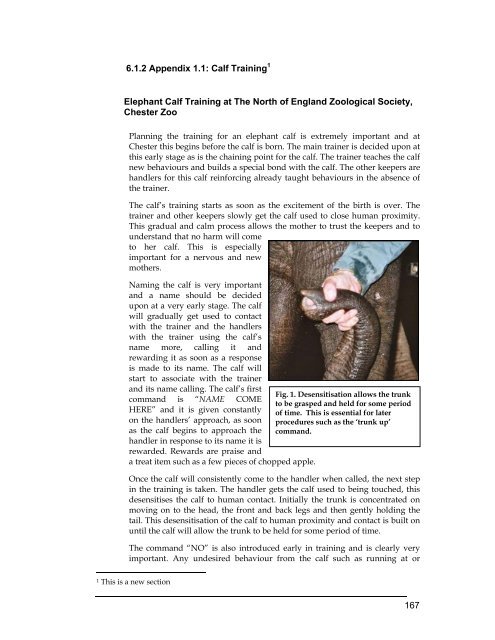Elephants Elephants - Wildpro - Twycross Zoo
Elephants Elephants - Wildpro - Twycross Zoo
Elephants Elephants - Wildpro - Twycross Zoo
Create successful ePaper yourself
Turn your PDF publications into a flip-book with our unique Google optimized e-Paper software.
6.1.2 Appendix 1.1: Calf Training 1<br />
Elephant Calf Training at The North of England <strong>Zoo</strong>logical Society,<br />
Chester <strong>Zoo</strong><br />
Planning the training for an elephant calf is extremely important and at<br />
Chester this begins before the calf is born. The main trainer is decided upon at<br />
this early stage as is the chaining point for the calf. The trainer teaches the calf<br />
new behaviours and builds a special bond with the calf. The other keepers are<br />
handlers for this calf reinforcing already taught behaviours in the absence of<br />
the trainer.<br />
The calf’s training starts as soon as the excitement of the birth is over. The<br />
trainer and other keepers slowly get the calf used to close human proximity.<br />
This gradual and calm process allows the mother to trust the keepers and to<br />
understand that no harm will come<br />
to her calf. This is especially<br />
important for a nervous and new<br />
mothers.<br />
Naming the calf is very important<br />
and a name should be decided<br />
upon at a very early stage. The calf<br />
will gradually get used to contact<br />
with the trainer and the handlers<br />
with the trainer using the calf’s<br />
name more, calling it and<br />
rewarding it as soon as a response<br />
is made to its name. The calf will<br />
start to associate with the trainer<br />
and its name calling. The calf’s first<br />
command is “NAME COME<br />
HERE” and it is given constantly<br />
on the handlers’ approach, as soon<br />
as the calf begins to approach the<br />
handler in response to its name it is<br />
rewarded. Rewards are praise and<br />
a treat item such as a few pieces of chopped apple.<br />
Once the calf will consistently come to the handler when called, the next step<br />
in the training is taken. The handler gets the calf used to being touched, this<br />
desensitises the calf to human contact. Initially the trunk is concentrated on<br />
moving on to the head, the front and back legs and then gently holding the<br />
tail. This desensitisation of the calf to human proximity and contact is built on<br />
until the calf will allow the trunk to be held for some period of time.<br />
The command “NO” is also introduced early in training and is clearly very<br />
important. Any undesired behaviour from the calf such as running at or<br />
1 This is a new section<br />
Fig. 1. Desensitisation allows the trunk<br />
to be grasped and held for some period<br />
of time. This is essential for later<br />
procedures such as the ‘trunk up’<br />
command.<br />
167

















